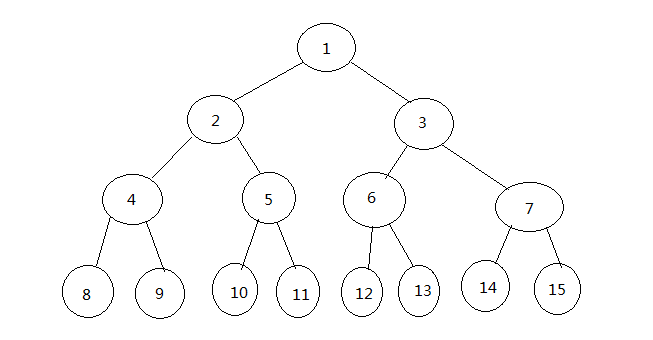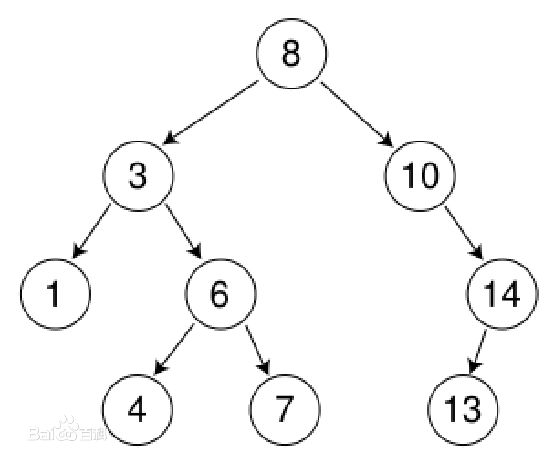二叉树
是什么?
二叉树就是每个节点(Node)最多只有
两个子节点
的树结构,且子树有
左右之分
,不能任意颠倒顺序.

根据二叉树的特性,便有了
二叉排序树
. 一般数据以二叉树作为数据结构储存时,都是按照二叉排序树的一般规则(“小放左,大放右”).

为了各位检验,main()函数和测试数据在最后给出.
二叉树节点定义
struct Node {
int val;
Node *lson, *rson;
Node(int v=0, Node *ls=NULL, Node *rs=NULL): val(v), lson(ls), rson(rs) {};
};二叉排序树创建
void read(int s[], int st, int ed) {
queue<int> tmp;
for(int i=st; i<ed; ++i) tmp.push(s[i]);
swap(tmp, buf);
}
bool build() {
while(!buf.empty()) {
if(!insert(root, buf.front())) return false;
buf.pop();
}
return true;
}
bool insert(Node *(&x), int v) {
if(x == NULL) {
x = new (std::nothrow) Node(v, NULL, NULL);
if(x == NULL) return false;
} else {
if(v < x->val) {
return insert(x->lson, v);
} else if(v == x->val) {
/* 按需调整 */
// return insert(x->lson, v);
// return insert(x->rson, v);
return true;
} else {
return insert(x->rson, v);
}
}
return true;
}写了这么个建树函数后,一定是需要检验的了,而检验的方法,一般就是列出四个遍历方式(先序,中序,后序,按层),判断是否正确咯.
这里给出各种遍历的代码.
先序遍历
void _pre_tra(Node *x) {
if(x) {
cout << x->val << " ";
_pre_tra(x->lson);
_pre_tra(x->rson);
}
}
void preorder_traversal() {
_pre_tra(root);
cout << endl;
}中序遍历(一般可认作从小到大输出)
void _in_tra(Node *x) {
if(x) {
_in_tra(x->lson);
cout << x->val << " ";
_in_tra(x->rson);
}
}
void inorder_traversal() {
_in_tra(root);
cout << endl;
}后序遍历
void _post_tra(Node *x) {
if(x) {
_post_tra(x->lson);
_post_tra(x->rson);
cout << x->val << " ";
}
}
void postorder_traversal() {
_post_tra(root);
cout << endl;
}按层遍历 (我认为思想与bfs(宽度搜索)完全一样). 按层遍历十分重要,下面几种二叉树相关的算法我都是用次实现的.
void level_traversal() {
queue<Node*> que;
if(root == NULL) return;
que.push(root);
while(!que.empty()) {
Node *cur = que.front();
que.pop();
cout << cur->val << " ";
if(cur->lson) que.push(cur->lson);
if(cur->rson) que.push(cur->rson);
}
cout << endl;
}分割线
二叉排序树类实现
class BSTree {
private:
struct Node {
int val;
Node *lson, *rson;
Node(int v=0, Node *ls=NULL, Node *rs=NULL): val(v), lson(ls), rson(rs) {};
};
Node *root;
queue<int> buf;
void _pre_tra(Node *x) {
if(x) {
cout << x->val << " ";
_pre_tra(x->lson);
_pre_tra(x->rson);
}
}
void _in_tra(Node *x) {
if(x) {
_in_tra(x->lson);
cout << x->val << " ";
_in_tra(x->rson);
}
}
void _post_tra(Node *x) {
if(x) {
_post_tra(x->lson);
_post_tra(x->rson);
cout << x->val << " ";
}
}
public:
BSTree() {
root = NULL;
}
~BSTree() {
clear();
}
void clear() {
queue<int> tmp;
swap(buf, tmp);
queue<Node*> que;
if(root == NULL) return;
que.push(root);
while(!que.empty()) {
Node *cur = que.front();
que.pop();
if(cur->lson) que.push(cur->lson);
if(cur->rson) que.push(cur->rson);
delete cur;
}
root = NULL;
}
void read(int s[], int st, int ed) {
queue<int> tmp;
for(int i=st; i<ed; ++i) tmp.push(s[i]);
swap(tmp, buf);
}
bool build() {
while(!buf.empty()) {
if(!insert(root, buf.front())) return false;
buf.pop();
}
return true;
}
bool insert(Node *(&x), int v) {
if(x == NULL) {
x = new (std::nothrow) Node(v, NULL, NULL);
if(x == NULL) return false;
} else {
if(v < x->val) {
return insert(x->lson, v);
} else if(v == x->val) {
/* 按需调整 */
// return insert(x->lson, v);
// return insert(x->rson, v);
return true;
} else {
return insert(x->rson, v);
}
}
return true;
}
void preorder_traversal() {
_pre_tra(root);
cout << endl;
}
void inorder_traversal() {
_in_tra(root);
cout << endl;
}
void postorder_traversal() {
_post_tra(root);
cout << endl;
}
void level_traversal() {
queue<Node*> que;
if(root == NULL) return;
que.push(root);
while(!que.empty()) {
Node *cur = que.front();
que.pop();
cout << cur->val << " ";
if(cur->lson) que.push(cur->lson);
if(cur->rson) que.push(cur->rson);
}
cout << endl;
}
};使用样例:
8
23 45 12 6 7 89 13 47
#include <iostream>
#include <queue>
using namespace std;
/*
二叉排序树类定义
*/
int s[MAXN];
BSTree bst;
int main() {
int n;
while(cin >> n) {
for(int i=0; i<n; ++i) cin >> s[i];
bst.read(s, 0, n);
bst.build();
bst.preorder_traversal();
bst.inorder_traversal();
bst.postorder_traversal();
bst.level_traversal();
bst.clear();
break;
}
return 0;
}
版权声明:本文为kissablemt原创文章,遵循 CC 4.0 BY-SA 版权协议,转载请附上原文出处链接和本声明。